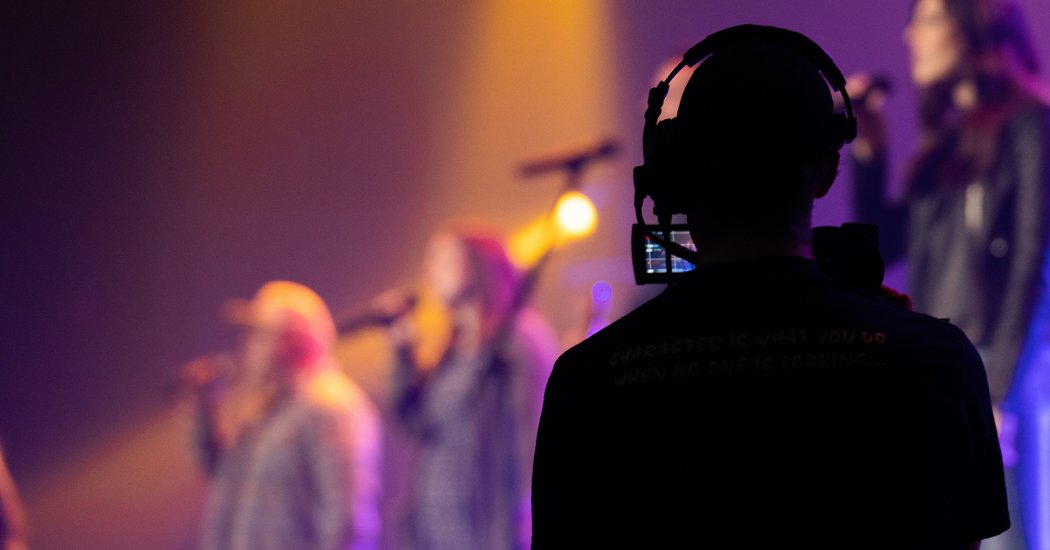
When considering shot length, it’s helpful to have a consistent starting place. But what benchmark is best? To accurately reflect the shot lengths used by many churches today, I studied online examples of large, medium, and small churches that practice worship styles ranging from traditional to modern and have a wide range of equipment and personnel. That’s a lot of shots! Here’s what that research revealed.
The primary determiner of shot length is the pace of the content. When capturing a person speaking, shots tend to be long, often static, and sometimes last 30 seconds or more. However, shot lengths are much shorter during musical moments.
For worship, most venues use a combination of short, medium, and long shots. The average length of these shots is determined by the church’s style, the intensity of the music, and the use of motion. Typically, short shots are static. Long shots usually include pushes, pulls, pans, or other camera motions supplemented by mounts, tracks, gimbles, and booms. Medium shots are a mix of motion and static. Overall, the shots strive to convey the sense of engagement, emotion, and atmosphere in the room.
Common Approaches
Modern worship venues noted for high production quality tend to have the shortest shot lengths overall. Short, static shots are the most common, averaging 35%–86% of all shots used, each lasting approximately two seconds. About two-thirds of the remaining shots are long or medium and incorporate some form of motion (push, pull, push-pull, pan, boom, gimble, track, cable cam, etc.). Medium shots are approximately four seconds. Longer shots are approximately eight seconds. This combination results in a fast pace requiring a greater number of cameras overall, a higher ratio of manned cameras, and a well-practiced production team.
Typical worship venues use slightly lengthier shots, averaging four seconds for short shots, seven seconds for medium shots, and 10 seconds or more for long shots. Usually one-third of all shots are medium-length shots incorporating motion, and a somewhat smaller number are static medium-length shots. The remaining shots are mostly short, static shots supplemented by a handful of longer motion shots. While this combination is less production-intense than the modern approach, multiple cameras and rehearsed shot combinations are helpful.
Traditional worship venues and churches with smaller teams tend to use longer shots overall. Most shots last seven to 10 seconds, supplemented by longer shots lasting 15 or more seconds. While these shots are considerably longer than the average shot lengths used by modern and typical worship churches, incorporating some form of motion, even subtly, helps keep the longer shots interesting. Short shots of four seconds or less are seldom used. This approach is easier for a small team or even a single person to accomplish successfully with PTZ cameras.
Outside of church venues, shot lengths also vary. Entertainment music-video shots average one-half to two seconds, and classic-rock music-video shots average four to eight seconds. American cinema shots average five to seven seconds (two to six for action movies), and European cinema tends to be considerably longer. Web video averages four seconds. These shot lengths are what your congregation tends to be used to, so they set a mental preconception of quality.
Motion Can Double Your Fun
Adding motion to shots allows you to effectively double effective shot length while still keeping the attention of your viewers. (Most shorter shots are static.) Consider pushes (zooming in), pulls (zooming out), pans (side to side), and — less commonly — rises or falls (panning vertically). Using gimbals, booms, and tracks can help smooth or automate the shot’s movement.
Typically, the speed of motion is fairly slow, but it should match the pace of the content. It’s also a good practice to alternate static and motion shots to avoid a sense of seesaw discomfort for the viewer. One rule of thumb is to replicate your eye’s natural movement and pace as if you were in the room live.
Pro Tip: Zoom in a camera to its target and focus before pulling back to your initial shot framing.
Which Shot Length Combination Is Right for You?
You may find it helpful to view a number of services from churches of similar style and size (or slightly larger) to yours. With the sound reduced or turned off, note the number of shots and their duration, scope, angle, and motion. Other considerations include your camera and production setup, your team’s level of experience, the available prep time everyone can regularly invest, and whether you are streaming live or have time to make post-production adjustments.
In addition to how you want to present your church, think about the audience you want to engage. List the related expectations they may have, the devices they use for viewing, and the potential consequences of not meeting their expectations. While most churches want to present themselves to potential visitors in the best possible light, it is important to many churches to authentically convey the experience that the guest will have when attending in person.
Another factor to consider is the willingness of the people you want to capture on video to adapt their movement to be compatible with recording video. For example, it is quite challenging for a volunteer camera operator, an automated camera, or a PTZ camera operator to successfully frame a tight chest-to-head shot of a pastor who likes to traverse the stage quickly. If that pastor is unwilling to adapt, then tight shots conveying expression and emotion may become unusable.
With these factors, you can create an effective plan to represent your church to the world.
Ask a Pro
Your Sweetwater Sales Engineer is an excellent resource as you develop your video-production setup and help your video technicians communicate for success. Call us at (800) 222-4700 for expert advice or visit Sweetwater.com.


